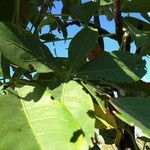A deciduous tree. It can be 8-14 m tall. It has a heavy rounded crown. The trunk is clear. It can be 1 m across. The bark is pale brown or grey white. It has long cracks along it and the ridges are sticky. The base of old trees has scales. The leaves occur opposite one another. They are compound leaves arranged like the fingers on a hand with 5 leaflets. They are leathery and shiny. Each leaflet can be 5-18 cm long and 3-7.5 cm wide. They have a common leaf stalk which can be 22 cm long. The base of the leaflet is wedge shaped and the tip is rounded. The flowers have a smell. They occur in dense bunches of up to 20 on a long stalk. The flower bunch can be 12 cm across. Each flower is cream with one hairy violet lobe. The outer case of the flower bud forms a hairy cup around the base of the fruit. The fruit is smooth and oblong and 3 cm long. It is green marked with white dots. The fruit turn black when ripe. The pulp is edible. Inside there is a hard nut with 1-4 seeds.
Leaves (3)4–5(6)-foliolate; petiole 5–17 cm long, grooved; median petiolules 0.4–2 cm long; leaflets 7–23 × 3–9 cm, median leaflet largest, broadly-obovate or sometimes narrowly obovate, rounded or emarginate to cuspidate and shortly acuminate at the apex, ± asymmetric and cuneate at the base, coriaceous, entire, concolorous shiny and glabrous above, not gland-dotted, midrib sometimes puberulous beneath, nerves raised beneath.
Deciduous much branched tree 4–18 m tall; bark with vertical fissures and stringy ridges or smooth, pale grey-brown, sometimes reddish-brown; older branches brownish-red, yellow and grey; young branches shortly tomentose or glabrescent, with reddish-brown buds.
Fruit a shiny edible drupe, 2–2.7 × 1.5–2.5 cm, obovoid-ellipsoid, rounded at the apex, the lower half not enclosed in the enlarged calyx, purplish-black at maturity; fruiting calyx saucer-shaped, pubescent, not gland-dotted.
Corolla 8–12 mm long, not gland-dotted, densely brown velvety tomentose outside; tube white or violet, 6–8 mm long, curved; lobes mauve, at obtuse angle to tube, middle lower lobe c. 3 × 4 mm.
Inflorescences axillary, of sturdy ± densely-flowered compound dichasia, 2.5–10 cm long, orange-tawny tomentose; bracteoles 0.2–0.3 cm long, linear, caducous.
Calyx conical, shallowly 5-toothed, rusty-brown lanate, not gland-dotted, accrescent in fruit; tube 2.5–4 mm long; teeth c. 0.5–1.5 mm long, erect.
Ovary obovoid and almost truncate apically, not gland-dotted, crowned with erect rigid hairs; style c. 7 mm long.
Stamens scarcely exserted from corolla tube; filaments with glandular hairs.
Tree 30-60 ft. high, with glabrous branches
5-foliolate, coriaceous leaves


